Common ragweed
Ambrosia artemisiifolia
Appearance
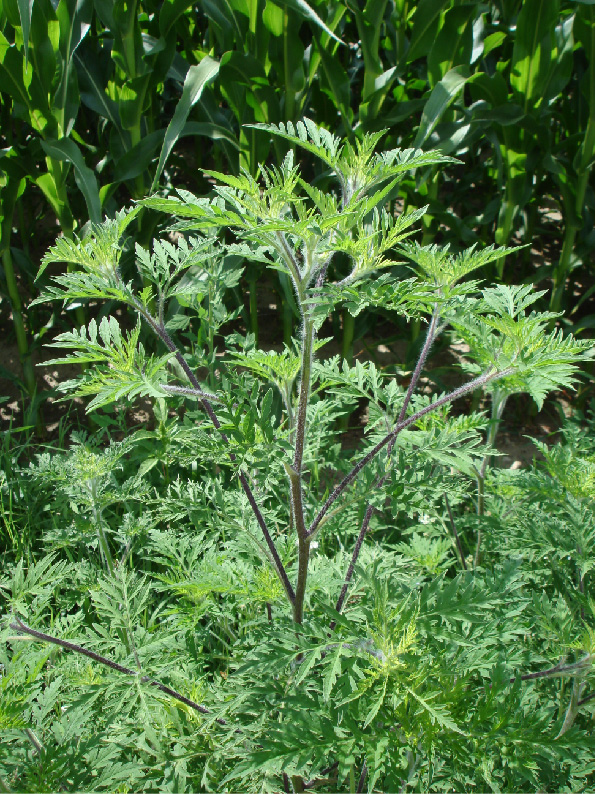
Ragweed(Ambrosia artemisiifolia, Asteraceae) is an annual herbaceous plant and grows up to 150 (180 under good conditions) cm high. It has a taproot and an erect, reddish stem that is hairy, especially in the upper part. The plant is strongly branched and bushy.
The leaves are short hairy, green on both sides, triangular to oval in outline, one to two pinnately lobed with coarsely toothed segments. The species is monoecious (female and male flowers in separate inflorescences, but on the same plant).
The plant forms a spike-shaped inflorescence (up to 15 cm) and the male yellow-green flower heads are arranged on it like racemes. The greenish female flowers are found below the male flower. The seeds are covered with five to seven spines. A single plant can produce between 3,000 and 60,000 seeds, which can remain germinable in the soil for several years.
Distribution
Ragweed colonizes fallow land, disturbed areas, private gardens, road or railroad verges, gravel pits, construction sites, and agricultural land.
Ragweed arrived from North America in the mid-19th century, probably as a stowaway in cereal or sunflower seeds, and has been spreading in Europe ever since. In Austria, the plant has been spreading steadily for years and has long been naturalized in the warm lowlands in the east and southeast of the country. Northern and southern Burgenland and Styria with the districts of southeastern Styria, Hartberg-Fürstenfeld and Leibnitz are particularly affected. In the west, occurrences are mainly restricted to the high-level road network, at the same time there are individual finds in settlement areas and in fields.
As a result of climate warming, the potential range will probably increase, and an increased spread to other parts of Austria can be expected.
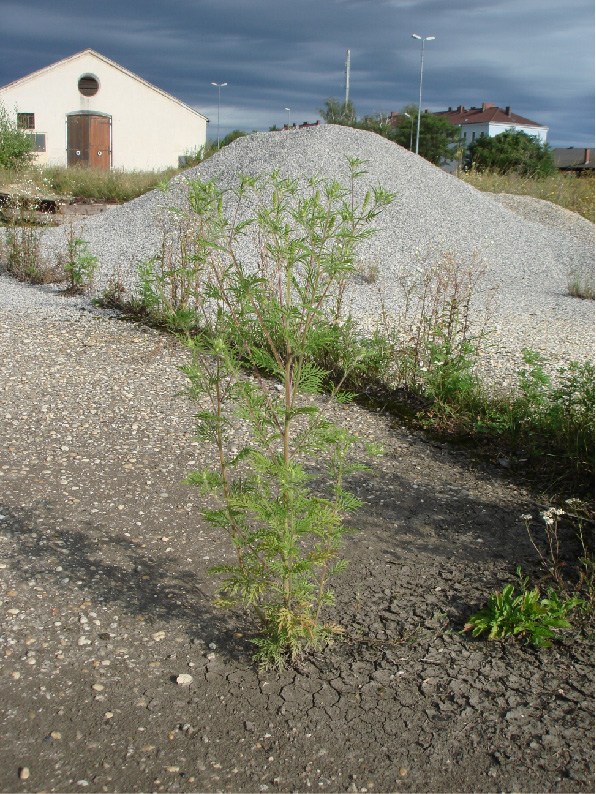
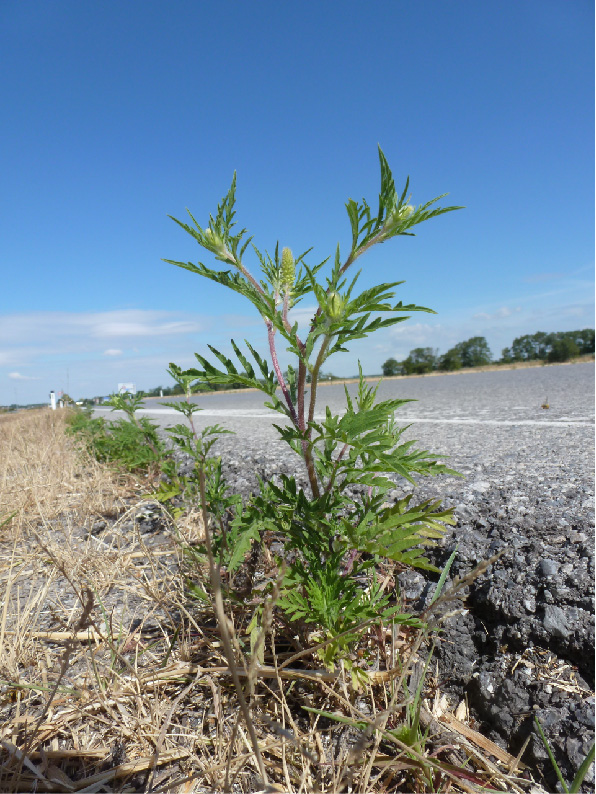
Propagation and transmission
In agriculturally dominated regions, spread occurs primarily through contaminated agricultural equipment. Thus, large quantities of ragweed seeds are carried from field to field, sometimes over long distances. Again and again, new infestations occur in the immediate vicinity of arable land as a result of construction activities (including road and path construction). In general, the movement of contaminated soil is becoming increasingly important as a spreading route. (Untested) seed for catch crops, wild fields, greening or wildflower sowings can be contaminated with ragweed seeds and is therefore a spreading possibility that should not be underestimated.
Economic importance
Ragweed has become a real problem weed in various agricultural crops such as soybean, sunflower and oil pumpkin. With adequate water and nutrient supply, the plant reaches a considerable size and in some cases also occurs over a wide area and can cause sensitive yield losses. The pollen of ragweed causes severe allergic reactions in sensitive people. The late flowering time of the plant is particularly unpleasant for allergy sufferers, as the pollen season is extended by two months into the fall.
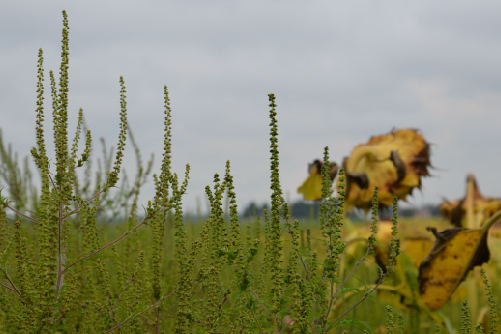
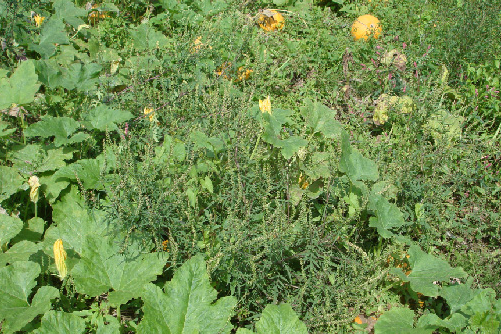
Prevention and control
Ragweed can generally be controlled relatively well in agriculture with the help of the usual crop protection measures. However, in some crops, such as oil pumpkin or soybean, control is still a challenge. In principle, fields should be consistently monitored for ragweed plants in order to quickly control an initial infestation and prevent the buildup of a permanent seed bank.
Effective decimation of ragweed is possible through adapted crop rotation. On heavily infested areas, crop rotation should be limited to winter rape, winter cereals and early potatoes. Cultivation of competitive crops such as cereals and maize in combination with targeted herbicide application (see list of plant protection products approved in Austria) and post-harvest treatments are effective measures. In corn, control success of nearly 100% can be realized with currently approved herbicides.
Individual plants (e.g. in home gardens) should, if possible, be pulled out, including the roots, before flowering and disposed of in sealed garbage bags via household waste. Areas with patchy vegetation cover, verges and embankments along paths and roads should be checked for ragweed and existing plants removed accordingly.
Specialized information
Publications
Follak, S., Schleicher, C., Schwarz, M., Essl, F., 2017. major emerging alien plants in Austrian crop fields. Weed Research, 57, 406-416.
Schindler, S., Bayliss, H. R., Essl, F., Rabitsch, W., Follak, S., Pullin, A., 2016. Effectiveness of management interventions for control of invasive Common ragweed Ambrosia artemisiifolia: a systematic review protocol. Environmental Evidence, 5(11).
Essl, F., Biró, K., Brandes, D., Broennimann, O., Bullock, J.M., Chapman, D. S., et al, 2015. Biological Flora of the British Isles: Ambrosia artemisiifolia. Journal of Ecology, 103, 1069-1098.
Projects
Ragweed: dispersal biology and management of an extremely allergenic introduced plant - pathways and causes of ragweed(Ambrosia artemisiifolia) spread and options for its control.
Last updated: 12.03.2024
automatically translated